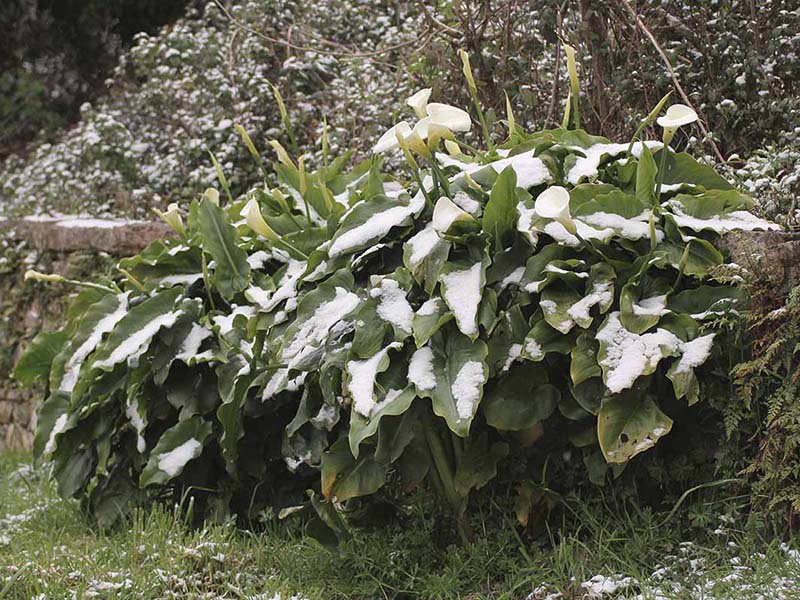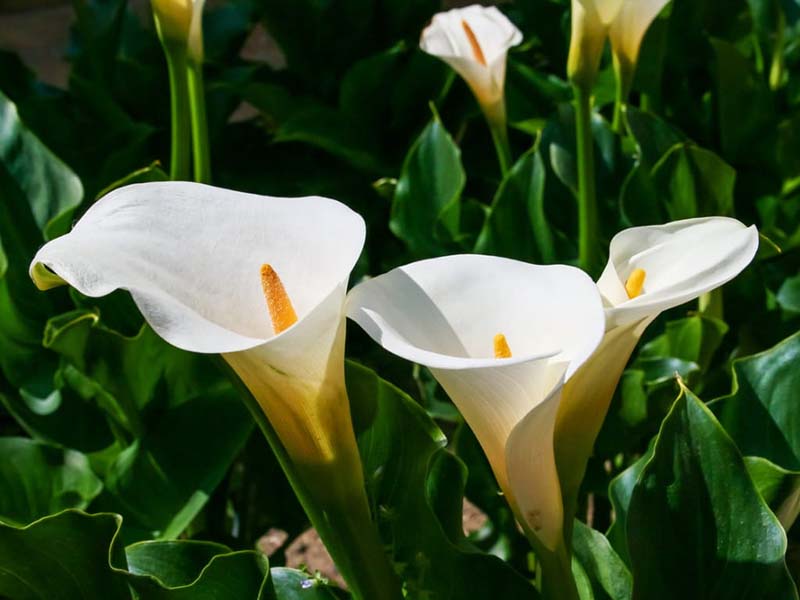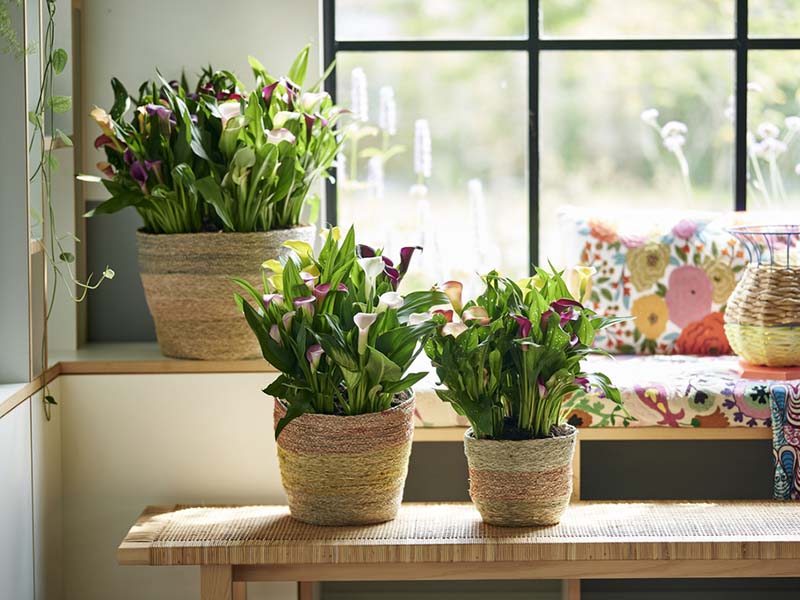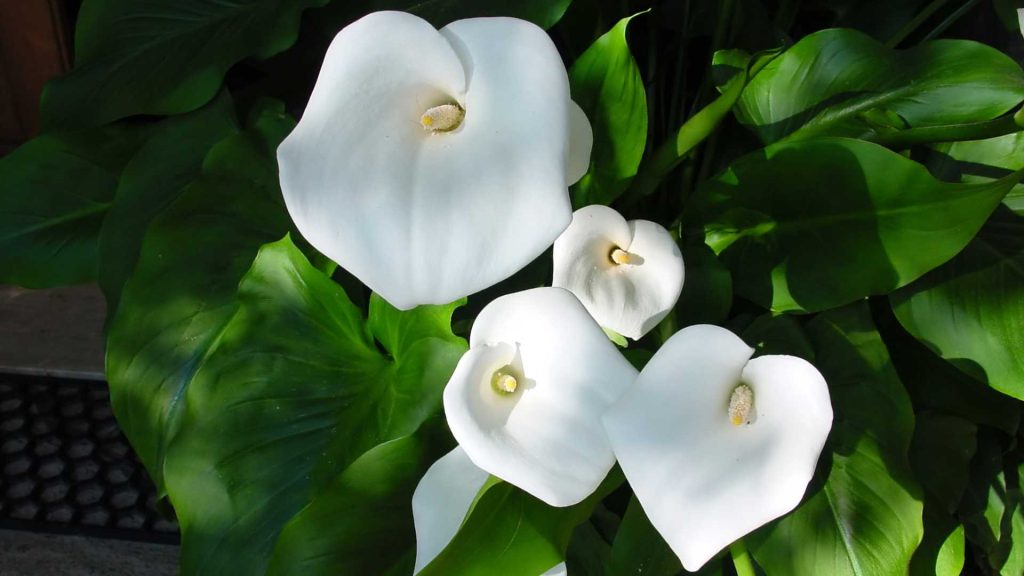The Calla lily plant has already won the hearts of many gardeners, and this is not at all surprising, because such a beautiful plant is not as difficult to care for as it might seem at first glance. Today, we want to tell you how to care for a Calla lily and what this lovely plant requires.
They are tropical flowering plants that thrive in USDA zones 8-10. The plants may die back in the summer and sprout the following year, however, in colder climates, these plants should be planted as an annual. To maintain this plant healthy, recreate its native habitat with moisture, warmth, and light. They grow from a rhizome rather than a bulb, indicating that they aren’t real lilies.
When Do Calla Lilies Bloom
If the plants are planted in the spring, they bloom for 3-8 weeks from mid-summer to September. The length of time it takes for them to blossom is determined by the temperature, amount of light, and plant variety. Calla lilies can bloom from mid-April to June in regions where they are perennial. It is worth noting that care for Calla lilies after blooming requires special attention from the gardener, but we will tell you about this below.
Now that we have gotten to know this plant better, let’s find out how to care for a Calla lily.
How Do You Take Care of a Calla Lily

Lighting
When growing Calla lilies indoors, choose such places as a sunny windowsill, a heated greenhouse, or a conservatory. The plant also needs good lighting all year round, which is an integral part of care for a Calla lily as a houseplant. In winter, there can be a lack of lighting. With a lack of light, the culture may not bloom, letting only the stems grow. Outdoors, Calla lilies enjoy open spaces and fertile soils, but they should be shaded during the warmest hours of the day: in the searing sun, the leaves wither, burn and dry out, therefore shrubs or trees should be planted nearby. The afternoon will give the Calla lilies a saving shade.
Soil
Selecting the right soil is the key to quality care for a Calla lily plant, both indoors and outdoors. To keep the plants flowering, use rich, well-drained soil. These plants are commonly seen growing around ponds and can survive a damp soil environment. Allowing these plants to become soggy can cause root rot, so be careful.
Water
Maintaining a suitable watering schedule is an integral part of quality Calla lily care, both indoors and outdoors. Don’t overwater your plants, especially after they’ve been planted. Water the plants once a week once the rhizomes have established, or more frequently if the weather is very hot or drought-like.
Humidity and Temperature
When caring for a Calla lily indoors, it is important to maintain a temperature of 71-77 °F in summer, and in winter at a temperature of at least 57 °F. They also like a lot of humidity and wetness, so the flowers don’t stop blooming in humid summers. The plants go into dormancy when the temperature drops below 50° F. Caring for Calla lilies potted outdoors requires gardeners to maintain temperatures from 60 to 75 degrees F during the day. Therefore, as soon as the temperature drops below or rises above this range, they should be brought into the house.
Remember that for both white and colored Calla lilies, high temperatures combined with low humidity are destructive – they are often affected by pests. Sharp temperature drops lead to the cessation of flowering.
Fertilizer
To ensure abundant blossoming, Calla lilies require feeding when they are first planted and again in the spring at the start of the growing season. The majority of well-balanced fertilizers will suffice. Avoid using a nitrogen-rich blend since it will prevent the plant from blooming.
Repotting
When the dormant period ends, Calla lilies are transplanted into fresh soil. With regular pinching of fresh shoots and replacing the top layer of earth in the flowerpot, Calla lilies can not be transplanted for 2 years.
White flowers should be planted in pots that are suitable for tubers (at least 6 inches in diameter), but not very deep. Place a drainage layer of 2 inches in it, substrate. You can purchase a versatile substrate for flowering indoor crops.
It is not recommended to place the Calla rhizome too deep, the same as on the surface. To calculate the correct depth, the diameter of the rhizome must be multiplied by three. When the plant is transplanted, the temperature should be raised a little. When it starts to grow actively (after 2-3 weeks), you can start active watering and feeding.
Even though Calla lily is a rather picky plant, it needs careful care in winter.
Calla Lily Winter Care

In the autumn, after the first frost, dig out the rhizomes and shake off any dirt. Before storing the rhizomes for the winter, leave them to dry for a few days. Calla lilies should be preserved in peat moss and kept in a cold, dry place, ideally in the dark, until spring arrives. Similarly, you can start growing Calla lilies indoors in January-February and bring them outside in the spring, providing you take care of them as usual. When Calla lilies are raised or during their dormancy phase, they can be split.
Calla Lily Propagation
They can be grown from seeds or by splitting their rhizome or rooting system. Calla lilies grow in big clumps that may be divided into individual plants. After the rhizomes have bloomed and their foliage has become entirely yellow, the optimum time to split them is towards the conclusion of the growing season. This normally happens in the summer or early fall, just before they become dormant. Rhizome-grown plants blossom considerably sooner than seed-grown plants. To propagate a Calla lily rhizome, follow these steps:
- You need a shovel or a pitchfork to dig out your Calla lily’s rhizome if it’s in the ground.
- You require a clean pot and potting soil if you want to grow your Calla lily indoors.
To make it simpler to pull up the root, carve a circle around it with the shovel or pitchfork.
Brush off the dirt from the rhizome and set it in a shaded, well-ventilated spot for several days after pulling off the clumped root. It should not be damp or water.
After it has dried, separate the rhizomes with a sharp knife. They don’t have to be separated exactly where they link, but they should have at least one root sprouting from each piece of the rhizome. Replant the rhizome in a compost-rich garden bed at about 6 inches apart from other plants, or pot it in moist, well-draining soil. Alternatively, the rhizomes can be stored over the winter.
How to Start Growing Calla Lilies from Seed
A Calla lily sown from seed might take up to three years to blossom. Calla lily seeds may be pre-grown by spreading them out on a wet paper towel and covering them with it. Place the paper towel somewhere cool, such as a basement or cellar. Check for growth after a few days. Those which don’t exhibit any indications of life should be discarded.
Place the Calla lily seed in a well-draining pot with high-quality soilless media and take good care of it. With the thinnest layer of potting media, plant two seeds in each container. Keep the soil wet and keep an eye on it for signs of growth. After a few weeks, check the plants and pluck the weakest sprout from each container. Each container should only have one seedling. After that, you can start caring for Calla lily plants as usual.
Calla Lily Care after Blooming Outdoors

Calla lily care after blooming outdoors is no different from caring for these plants after blooming indoors. Remove any fading or dead flower stems or leaves on a regular basis. Feed and water the plant for many weeks after flowering has ceased, being careful not to overwater, until the leaves begin to fall back. Bring plants in pots indoors before the first frost and leave them in their pots until they are dormant.
Growing Calla Lilies in Pots

Calla lilies may be grown inside sooner than they can be started outdoors in some areas by growing them in a container. This allows you to plant established, ready-to-bloom Callas on the terrace or patio early in the spring. Calla lilies grown in containers can be planted early and timed to bloom for Easter or spring weddings. How to grow Calla lilies in pots?
Cover the Calla lily bulb with a paper towel and just enough water to wet the soil. Calla lily plants must be planted in a tall container with plenty of areas to develop and proper drainage. Give the plant lots of water and lightly cover the roots with potting dirt.
How to Care for a Potted Calla Lily
- Keep the soil moist but not soggy.
- Ascertain that there is sufficiently bright, indirect lighting.
- While the plant is in bloom, use a liquid fertilizer once a month.
- Keep a safe distance from heating and cooling vents.
- Reduce the amount of watering when the plant is dormant.
- Cut the leaves once they have dried.
Diseases and Pests
Diseases are usually caused by improper care for Calla lily indoors/outdoors and a lack of attention to the plant. Most often, diseases are caused by fungal infections. To prevent diseases, the condition of the soil should be very carefully monitored.
It should not dry out and there should be no stagnation of moisture in it. It is also required to protect the plant from direct sunlight to avoid burns, and also protect it from drafts.
The increased humidity of the air and soil leads to the appearance of gray rot. It manifests itself in the form of a gray bloom. It is treated with fungicides and regular airing of the apartment. Over-watering often leads to root rot. Therefore, proper watering is the key to the successful growth of Calla lilies. If the flower can still be saved, then the soil must be replaced with a dry one, and the amount of watering must be reduced. It is also necessary to add to Calla lily care the use of fungicidal preparations;
Why Calla Lilies Don’t Bloom
This question cannot always be answered with confidence. There may be several factors that can cause this problem. The presence of many bulbs that have not been transplanted for a long time, frequent transplants, changes in flower pot locations, improper care. All this weakens the mother plant, and Calla does not bloom. The Calla lily is an excellent houseplant that, with the right care, can grow well outside. Observing simple growing rules, you can achieve regular flowering, healthy greenery, and as a result, additional decoration of any interior or garden. Calla is considered not only a wedding flower, but also a flower of luck. Plant it in your suburban area and check it out for yourself!


